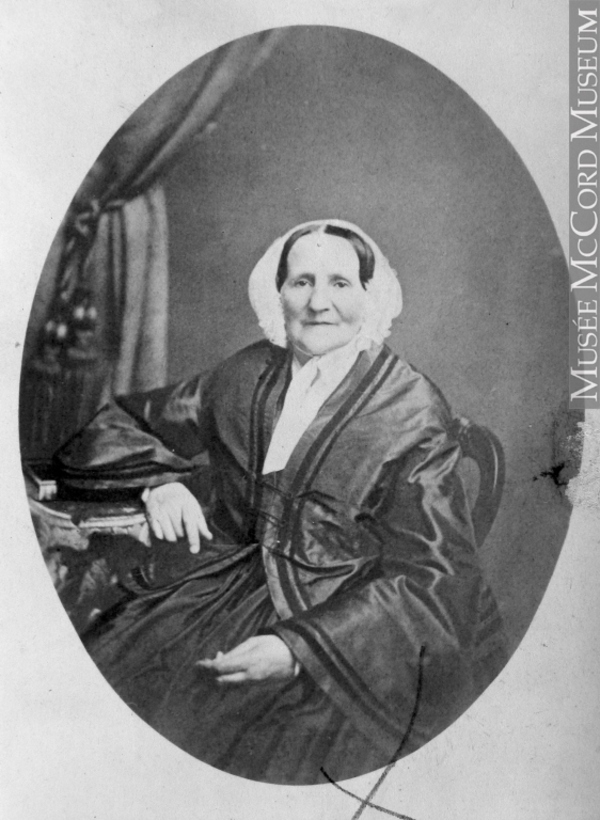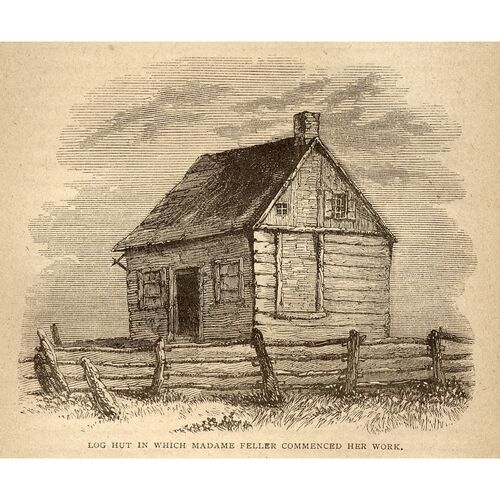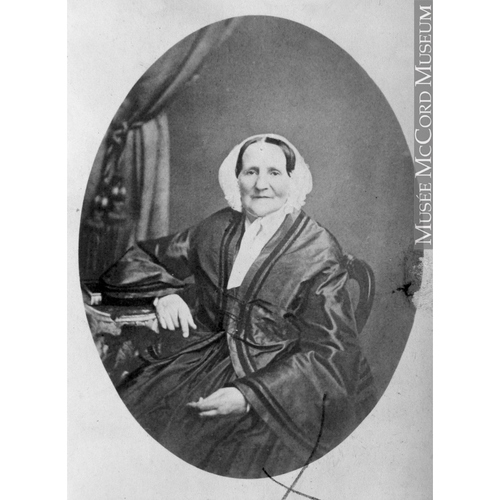
Source: Link
ODIN, HENRIETTE (Feller), founder of the French Canadian Protestant mission at Grande-Ligne, Lower Canada; b. 22 April 1800 at Montagny, canton of Vaud, Switzerland; d. 29 March 1868 at Grande-Ligne, Que.
In 1803 Henriette Odin moved with her parents to Lausanne, where her father had been appointed director of the canton’s hospital and was later to be administrator of a penitentiary. In this environment she acquired some medical knowledge that would be helpful in her apostolate in Canada.
The visit of a Scot, Robert Haldane, to Geneva in 1816–17 brought about a “religious revival” there that led his adherents to break from the official Protestant church, which they accused of a rationalist interpretation of the Scriptures and erroneous teachings on grace, predestination, and christology. The dissidents were persecuted under a law passed in 1824 that made them liable to a punishment as severe as exile. Two years earlier, in 1822, Henriette Odin had married Louis Feller, a 41-year-old widower and father of three children of whom the eldest was 14. Feller, the director of the Lausanne police, was responsible for applying the law; although his wife did not subscribe at that time to the dissidents’ credo, she could not tolerate their being hunted down, and in connivance with her husband did everything she could to protect them.
Little by little, her sympathy for them was transformed into an ardent faith, characterized by mystical impulses which her associates attributed to a morbid imagination, and indeed even to a neurosis resulting from the successive deaths, between 1822 and 1827, of her daughter (born the year of her marriage), husband, sister, and mother. She herself, stricken with typhoid fever, had to take a rest cure in the Jura. There she became convinced from reading the Bible that baptism could be administered only to believers, and on her return to Lausanne she was rebaptized by sprinkling, which was contrary to custom.
In 1828, about a year after Mme Feller had left the official church, the legal restrictions against dissidents were temporarily lifted. This gave the revival movement in Switzerland free rein for its initiatives. Theological discussions were revived; abundant and varied literature was disseminated; renewed efforts to proselytize were made through the founding of several biblical and missionary societies; controversy with Catholics was resumed; and new methods of spreading the gospel were introduced including colportage, preaching by itinerant pastors, and prayer meetings improvised in the most diverse places. These were not the only activities of the revival movement but through them it prospered and spread through Switzerland and France. Moreover several missionaries were sent to French Canada.
Mme Feller engaged herself in the Société des Missions Évangéliques de Lausanne which was founded in 1828. On the advice of the London Bible Society, this society sent to the Indians of Lower Canada Isaac Cloux, the missionary institute’s first student, who finished his training somewhat hastily. Cloux found the work too difficult and returned to Switzerland in 1832, after little more than a year’s absence. The evangelization of pagans was the sole objective of this society. It had categorically rejected the earnest request of some English residents of Montreal that it should devote itself to evangelizing French Canadians. For this reason when Henri Olivier, pastor of the dissident church at Lausanne, left for Canada in 1834, he had to sever his connections with the society since he had decided to work at Montreal rather than in the Indian territories. Mme Feller corresponded regularly with Mme Olivier, with whom she had been friendly at Lausanne. This exchange no doubt strengthened her intention to devote herself to the Canadian missions: in August 1835 she in turn left for Canada, accompanied by Louis Roussy*, who earlier had been a student at the missionary institute.
The experience of these missionaries among a people whom they at first described as “ignorant and superstitious” proved extremely painful. Olivier and his wife left the country after 15 months of work. Mme Feller and Roussy persisted, but at the cost of great frustrations. During the first year they had to abandon three schools which the Catholic clergy denounced. Colportage became increasingly difficult: the doors of houses were closed against them and they were sometimes ill treated. Unable to settle in towns and villages where the clergy exercised strict surveillance, they decided to withdraw to newly settled areas, where the clergy went infrequently and where the absence of public services inevitably encouraged good relations between neighbours.
This was the situation at Grande-Ligne, some ten miles south of Saint-Jean, when Mme Feller took up residence there in September 1836. The absence of a school and a doctor gave the missionaries their first means of spreading the gospel. They won the confidence of a number of families, so that at the time of the 1837 rebellion the little Protestant community numbered 16 converts and about ten sympathizers. However, with the revolutionary disturbances they were subjected increasingly to persecution. The Patriotes accused them of being supported by their English foes, and of not taking part in the movement. Then finally, in November, after a series of “charivaris” in front of Protestant homes, Mme Feller and the converts, fearing the worst, fled to the United States.
The 1837 rebellion, nevertheless, marked a stage in the advance of Protestantism. The English and Swiss evangelists of Lower Canada saw it as an opportunity to overcome the influence of the clergy, the greatest obstacle to the conversion of French Canadians. At the time of the exodus Mme Feller already noted: “One of the fortunate repercussions of this war is that it has broken the priests’ yoke; they have exerted no influence on the rebels, whom they tried to hold back by threats of excommunication; but nobody has taken any notice of them.” Louis Roussy made the same kind of statement in Swiss, English, and American papers: “And it is not only at Grande-Ligne, it is in the region generally that the influence of the priest is diminishing.” Mme Feller sounded the watchword: “The time is come, Canada is open.”
The pathetic newspaper description of their exodus set in motion a wave of generosity in the United States and Switzerland. Thus when she returned to Grande-Ligne, Mme Feller was able to distribute supplies, seed for planting, and medicines to some 50 persons. She also suspended legal action against those who had pillaged the converts’ dwellings, and went to Napierville to intercede on behalf of neighbouring inhabitants with Richard MacGinnis, who had been deputed by the government to receive statements and examine the accused. She could then write: “In general, the feeling of the people towards us has changed so much that I believe there is no house at Grande-Ligne which I cannot now enter.” The task of spreading the faith was accomplished at Grande-Ligne through the free school, colportage, and preaching; like the Catholic clergy of the time, Mme Feller also became involved in charitable works.
The success of the Swiss missionaries in spreading the Protestant gospel, the hopes aroused by the anticlericalism of the insurrectionary period, and the desire for a measure of political security, prompted the English pastors and laymen of various religious denominations in Montreal to found a new society, the French Canadian Missionary Society. According to the constitution formulated after the founding meeting, in February 1839, its objectives were exactly those pursued at Grande-Ligne: to convert French Canadians to Protestantism without linking them to a precise denomination. How then is one to account for Mme Feller’s refusal of the invitation to join the Montreal society? There is no easy explanation; at first sight a divergence of views about the age required for receiving baptism seems to have motivated this refusal. But it is more probable that she was first and foremost jealous of her own independence and anxious to preserve her almost absolute authority at Grande-Ligne. Despite a clear affinity of belief with the Baptists of Montreal, she preferred affiliation with the distant Foreign Evangelical Society of New York, and then, after 1845, with a number of Baptist societies in Canada and the United States. Indeed from the beginning she declared an intention to remain free to refuse any affiliation.
Henriette Feller personally made eight fundraising trips to the United States. As she spoke English badly, she took an interpreter who introduced her to the different religious associations, particularly the women’s associations which she had helped to establish. While travelling, she continued to take an interest in administrative matters at the Grande-Ligne school and mission, and insisted that Roussy or his substitute report to her every two or three days. However, her graciousness, devotion, accessibility, and abounding affection for students in particular caused this authoritarianism to be forgotten. In her correspondence with them she asked the students to call her “mother,” and signed herself “your affectionate mother, Henriette Feller.”
Her health was a constant source of anxiety for her close associates. Illness frequently kept her bed-ridden. In 1855 an attack of pneumonia, from which she never fully recovered, forced her to rest for seven months in the southern United States. A trip to Switzerland in 1860–61 brought no improvement. She was stricken with paralysis in 1865, and until her death on 29 March 1868 was compelled to direct the mission from her room, which she could leave only with difficulty.
That year, the society begun at Grande-Ligne numbered in the Province of Quebec about 400 members, and possessed nine churches; at least seven pastors worked in these churches, not including the evangelists and colporteurs. The school at Grande-Ligne taught 34 students, and a larger number of students received primary instruction in various other localities. In short, Mme Feller’s 32 years of missionary work in Canada yielded significant results; they were, however, diminished by steady emigration to the United States, which proved more attractive to a group of converts who had been banished from French Canadian society and recruited primarily from the working class.
To judge the results of her work by these figures alone would not do justice to Henriette Feller. She succeeded in setting up the first Francophone Protestant community in the province of Quebec, and inspired the work of several other reformed religious denominations which, around 1860, shared in trying to serve a small number of persons whom it was difficult to evangelize. Finally it should be noted that she managed to secure the collaboration of educated, influential French Canadians, among them the Patriote Dr Cyrille-Hector-Octave Côté*, and the defrocked priests Louis Normandeau and Hubert-Joseph Tétreau*; she also obtained an education in Switzerland for a number of talented students who later played an important role in the mission, including Narcisse Cyr, publisher and editor of the Semeur canadien, and the Reverend Théodore Lafleur, a prominent member of the Institut Canadien of Montreal, director of the Protestant school at Longueuil, and an influential minister at the Grande-Ligne mission.
The memory of the founder is alive even today among the adherents of the ten or so Protestant churches that owe their existence to Henriette Feller.
Evangelical Soc. of La Grande Ligne, Register (Grande Ligne, Que.), March 1866. French Canadian Missionary Soc., Report (Montreal), 1842–60. A memoir of Madame Feller; with an account of the origin and progress of the Grande Ligne Mission, trans. and ed. J. M. Cramp (London, [1876]). Soc. des missions évangéliques de Lausanne, Rapport (Lausanne, Suisse), 1830–50. R.-P. Duclos, Histoire du protestantisme français au Canada et aux États-Unis (2v., Montréal, [1913]). Henri Fines, Album du protestantisme français en Amérique du Nord (Montréal, 1972). Théodore Lafleur, A semi-centennial, historical sketch of the Grande Ligne Mission, read at the Jubilee gathering, Grande Ligne, Oct. 18th, 1885 (Montreal, [1886]). Léon Maury, Le réveil religieux dans l’Église réformée à Genève et en France (1810–1850), étude historique et dogmatique (2v., Paris, 1892). Daniel Robert, Les églises réformées en France, 1800–1830 (Paris, 1961). E.-A. Therrien et al., Baptist work in French Canada (Montreal, 1954). Paul Villard, Up to the light; the story of French Protestantism in Canada (Toronto, 1928). W. N. Wyeth, Henrietta Feller and the Grande Ligne Mission, a memorial (Philadelphia, 1898). Feuille religieuse du canton de Vaud (Lausanne, Suisse), 1830–1860.
Cite This Article
René Hardy, “ODIN, HENRIETTE (Feller),” in Dictionary of Canadian Biography, vol. 9, University of Toronto/Université Laval, 2003–, accessed January 11, 2026, https://www.biographi.ca/en/bio/odin_henriette_9E.html.
The citation above shows the format for footnotes and endnotes according to the Chicago manual of style (16th edition). Information to be used in other citation formats:
| Permalink: | https://www.biographi.ca/en/bio/odin_henriette_9E.html |
| Author of Article: | René Hardy |
| Title of Article: | ODIN, HENRIETTE (Feller) |
| Publication Name: | Dictionary of Canadian Biography, vol. 9 |
| Publisher: | University of Toronto/Université Laval |
| Year of publication: | 1976 |
| Year of revision: | 1976 |
| Access Date: | January 11, 2026 |




